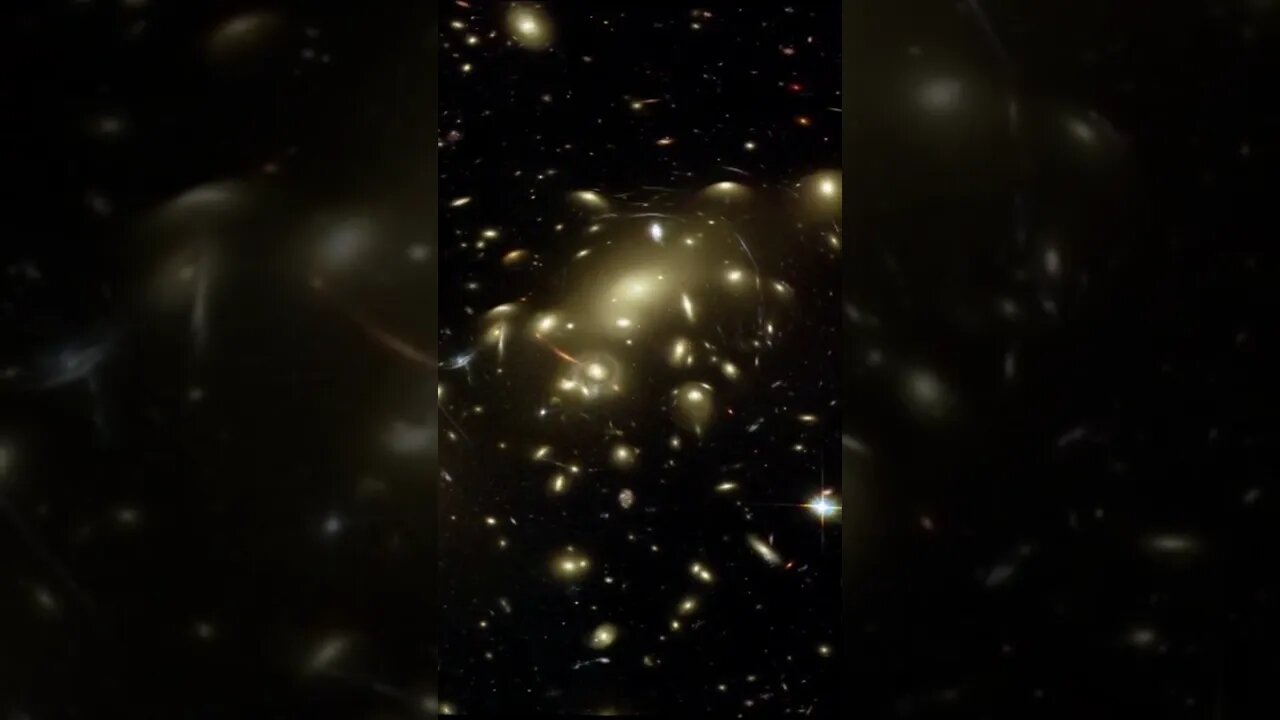Premium Only Content

Exploring the Depths of the Universe with Gravitational Lensing #shorts #space
Gravitational lensing is a phenomenon that occurs when the path of light from a distant object is curved by the gravitational pull of a massive object, such as a galaxy or a cluster of galaxies. This bending of light can cause the distant object to appear distorted or magnified, depending on the geometry of the gravitational lens.
The effect of gravitational lensing can be seen in a variety of astronomical observations, from the images of galaxies and clusters of galaxies to the cosmic microwave background radiation. In some cases, gravitational lensing can even be used to magnify distant objects that are otherwise too faint to be observed directly, allowing astronomers to study the properties of these objects in more detail.
One of the most famous examples of gravitational lensing is the Einstein Cross, which is a quasar that appears as four distinct images due to the gravitational lensing effect of a foreground galaxy. This phenomenon was predicted by Albert Einstein's theory of general relativity, which describes gravity as a curvature of spacetime.
Gravitational lensing has many applications in astronomy and astrophysics. By studying the distortions and magnifications caused by gravitational lenses, astronomers can learn more about the structure and evolution of the universe, as well as the properties of individual objects within it.
One of the most significant applications of gravitational lensing is in the study of dark matter. Dark matter is an invisible form of matter that is thought to make up a large fraction of the total mass in the universe, and its distribution can be inferred from the gravitational lensing effect it produces.
Gravitational lensing also allows astronomers to measure vast distances in the universe. Thanks to powerful instruments such as the Hubble Space Telescope and James Webb Space Telescope, we can view objects that predate the formation of our solar system. Gravitational lensing allows us to observe even further back in time during the formation of our early universe.
The picture shows Abell 2218, a rich galaxy cluster composed of thousands of individual galaxies. It sits about 2.1 billion light-years from the Earth (redshift 0.17) in the northern constellation of Draco. When used by astronomers as a powerful gravitational lens to magnify distant galaxies, the cluster allows them to peer far into the Universe. However, it not only magnifies the images of hidden galaxies, but also distorts them into long, thin arcs.
Several arcs in the image can be studied in detail thanks to Hubble's sharp vision. Multiple distorted images of the same galaxies can be identified by comparing the shape of the galaxies and their color. In addition to the giant arcs, many smaller arclets have been identified.
By using the gravitational magnification from six massive lensing galaxy clusters, the NASA/ESA Hubble Space Telescope has provided scientists with the largest sample of very distant galaxies seen to date. Some of the newly found magnified objects are dimmer than the faintest ones seen in the legendary Hubble Ultra Deep Field, which is usually considered the deepest image of the Universe.
By combining both visible and near-infrared observations from Hubble's Advanced Camera for Surveys (ACS) and Near Infrared Camera and Multi-Object Spectrometer (NICMOS), scientists searched for galaxies that are only visible in near-infrared light. They uncovered 10 candidates believed to lie about 13 billion light-years away (a redshift of approximately 7.5), which means that the light gathered was emitted by the stars when the Universe was still very young - a mere 700 million years old.
Styx AI, which is developing innovative techniques based on quantum mechanics, depth maps, generative imaging, machine learning, and new mathematics to move the lens of complex nonuniform spacetime. Its process can break down an image into nearly infinite pieces, providing greater depth and detail to reveal previously unseen information.
Gravitational lensing not only provides insight into the properties of distant objects but also into the distribution of dark matter in the universe. Dark matter is an invisible form of matter that is thought to make up a large fraction of the total mass in the universe, and its distribution can be inferred from the gravitational lensing effect it produces. "This stuff is cool."
Credit: NASA, ESA, and Johan Richard (Caltech, USA)
Acknowledgement: Davide de Martin & James Long (ESA/Hubble)
Processed by STYX AI
@NASA @NASAGoddard @NASAJPL @NASAgovVideo @NASAgovVideo @hubblespacetelescope @NASAWebbTelescope @EuropeanSpaceAgency @YouTube
#gravity #darkmatter #Abell2218 #HubbleSpaceTelescope
#JamesWebbSpaceTelescope #cosmicmicrowaveradiation
#earlyuniverse #EinsteinCross #galaxyclusters
#quantummechanics
-
 LIVE
LIVE
The StoneZONE with Roger Stone
4 hours agoWhy Democrats Hold Poor Children Hostage in Failing Schools | The StoneZONE w/ Roger Stone
875 watching -
 LIVE
LIVE
Tundra Gaming Live
4 hours agoThe Worlds Okayest War Thunder Stream//Air Force Vet Flys Jets
125 watching -
 2:00:54
2:00:54
Redacted News
5 hours agoBREAKING! Putin just SHOCKED the world, launches nuclear capable warheads "NATO can't stop it"
142K277 -
 55:37
55:37
Candace Show Podcast
5 hours agoMatt Gaetz Out, Jussie Smollett Walks Free! | Candace Ep 108
100K260 -
 54:43
54:43
LFA TV
23 hours agoTrump Has Learned His Lesson | Trumpet Daily 11.21.24 7PM EST
12.2K4 -
 DVR
DVR
theDaily302
12 hours agoThe Daily 302-Special Border Invasion Shutdown Show
7.84K -
 4:29:05
4:29:05
Tate Speech by Andrew Tate
12 hours agoEMERGENCY MEETING EPISODE 92 - IN THE TRENCHES
748K1.1K -
 1:01:23
1:01:23
In The Litter Box w/ Jewels & Catturd
1 day agoThe Trump Effect | In the Litter Box w/ Jewels & Catturd – Ep. 696 – 11/21/2024
81.4K33 -
 20:53
20:53
SLS - Street League Skateboarding
2 days agoGold Medals, World Class Food, Night life & more - Get Lost: Tokyo
75.9K7 -
 47:13
47:13
PMG
21 hours ago $1.26 earned"Hannah Faulkner and Doug Billings | WHY LIBERALS LOST THE ELECTION"
41.9K1